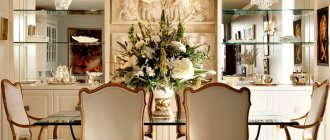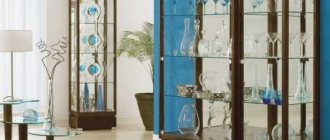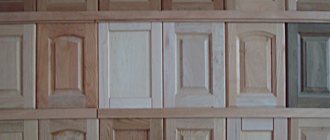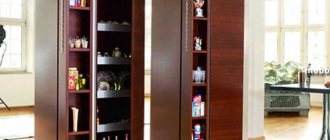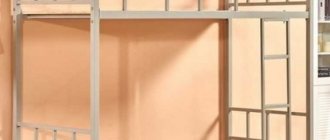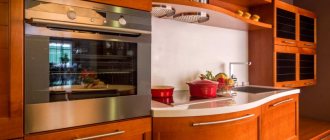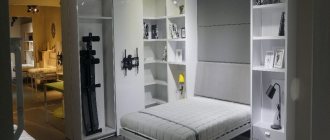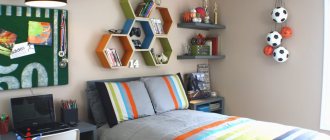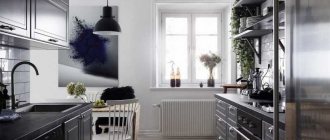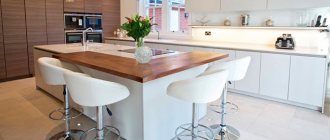Advantages and disadvantages of glass facades
Any finishing material has its pros and cons associated with the characteristics of its operation. The advantages of glass surfaces in the kitchen are the following factors:
- resistance to high humidity and temperature changes;
- strength (modern technologies make it possible to produce surfaces for facades that are insensitive to mechanical stress);
- hygiene (uniform texture prevents the formation of colonies of pathogenic bacteria);
- ease of care (there are a large number of available products for cleaning glass surfaces);
- texture compatibility with other finishing materials;
- the ability to use glass to decorate kitchens in various styles;
- beauty and grace.
The list of disadvantages of using glass surfaces in a food preparation room looks like this:
- characteristic noise when in contact with various utensils;
- high price;
- rapid contamination when touching surfaces with hands.
Glass kitchen facades - features
Classic facade materials - MDF, chipboard and natural wood - have been replaced by more practical and effective solutions in the form of glass panels.
They have a number of advantages:
- durability - high-quality glass can withstand even serious loads;
- resistance to humidity and high temperatures;
- wide possibilities for decoration, a huge selection of colors and textures;
- environmentally friendly - glass does not contain substances harmful to humans and the environment.
Please note that good glass facades are quite expensive. In addition, they need constant and careful care. Otherwise, the panels will look untidy.
Types of glass
This material has many variations that differ in production technology and physical properties. For kitchens, you should choose the most durable types of glass, especially for the lower tiers of the set. Upper facades are less likely to be subjected to mechanical stress and therefore allow the use of more fragile and affordable options. However, if possible, it is better to completely decorate the set with reliable materials.
Acrylic
Such glass is rarely used to decorate kitchen facades. This is due to the low thermal stability of acrylic. Under the influence of high temperatures, such surfaces can become deformed. Therefore, it is mainly used to decorate the upper tiers of the kitchen. This material is flexible during the finishing process. It is quite easy to cut and convenient to apply all kinds of decorative patterns.
Laminated
This procedure allows you to obtain more durable facades. Applying a protective film increases the reliability and service life of glass inserts. They become less susceptible to mechanical stress. Thanks to lamination, glass facades acquire a beautiful matte texture. Through such translucent glass, vague outlines of objects will be visible - this fact is important for those who do not want to display food and kitchen utensils. In addition to increasing strength, lamination allows you to apply any patterns to surfaces using special decorative films.
Tempered
After a certain heat treatment, glass for facades acquires high viscosity. The natural result of this is the strength and durability of products made from hardened material. If such an insert breaks, the glass shatters into many small cubes with rounded edges. It is impossible to cut yourself on such fragments. Another positive quality of tempered glass is heat resistance. Therefore, it is often used to decorate surfaces located in close proximity to the hob.
This material has disadvantages. One of them is the impossibility of drilling and cutting after finishing the processing. All holes necessary for the facades must be made before hardening. In addition, such glass has a large mass. This fact should be taken into account when organizing the movement of kitchen units.
Triplex
Such glass consists of two thin components connected using a polymerizing composition. Triplex has increased strength. Such a multilayer structure is difficult to break even if desired. If this happens, the fragments of the facade do not scatter in all directions. In addition, they do not have sharp edges. This fact makes the use of triplex safe for apartments where there are small children.
Glass decoration
A kitchen with glass elements, a photo of which can be viewed on the website, looks original and elegant in itself, but decorative details will not interfere with improving the appearance. Simple transparent glass is a classic option for the kitchen, which will appeal to lovers of traditional solutions. However, modern designers recommend diversifying the interior and adding a touch of style and modernity with the help of unusual vintage glass for kitchen facades.
- Colored glasses are available in hundreds of different shades that will suit any color set. The coloring pigment is added during the production of the product, so it does not fade in the sun. By the way, you can make an analogue for the kitchen at home. To do this, just cover the back surface of the glass with colored film.
- Frosted glass can often be seen in high-tech interiors. The outlines of objects located in the cabinets look impressive with spot internal lighting.
- Laminated glass surprises with its variety of designs and colors. This can be not just a banal darkening, but also an exclusive design or an original pattern. This is a budget option that can be applied to silicate glass yourself, further strengthening it.
- Ultraviolet photo printing is one of the latest design innovations. In addition to making an apron from stalinite and photo wallpaper with a 3D effect, there is now a unique opportunity to apply any design you like to glass kitchen facades. The image is transferred using a special printer and fixed in such a way that moisture does not penetrate there. In addition, the facades are not afraid of direct sunlight, so the design does not fade or fade.
- Sandblasted glass is a combination of frosted and transparent inserts in one product. With the help of this processing, a decorative stylish pattern is obtained, which becomes a decoration of the facade.
- Relief glass has a figured surface. A matte base is usually coated with a mesh or wavy texture, resulting in a raised and uneven finish.
- Stained glass is an exclusive and expensive glass decoration option for kitchen facades. Traditionally, these are colored fragments that are collected and mounted in a frame. Imitation is handmade using vintage paints. Using a stencil, you need to apply a design to the glass and outline the contours with gold or silver paint, and then paint the remaining areas in the desired color. This kitchen looks very impressive and original.
Decorative glass for kitchen units comes with a relief pattern, tinting or appliqué
Kitchen set with photo printing on a glass facade
Types of glass structures
There are several variations of facades made of this material. They differ in the way they are attached directly to the headset. For each, the type of glass recommended for installation should be used. The need for a selective approach is due to compliance with safety regulations.
Frame
This finishing method requires the presence of glass inserts of different sizes in facades made of solid wood, MDF, and chipboard. Aluminum profiles are also used to fasten fragments. Depending on the style of the kitchen, you can use wide and narrow frames for inserts. Such designs make it possible to use less durable types of glass, since the main load falls on the base material of the headset.
Frameless
This type of construction is also called solid or slab. This option involves installing facades made entirely of glass. The edges of the surfaces must be polished and placed in a thin metal profile. Only the strongest types of glass - tempered and triplex - are suitable as materials for the manufacture of frameless facades. The large weight of such structures requires the use of reliable and high-quality fittings for fastening.
Glass apron
The purpose of the apron is to protect surfaces from steam, moisture and grease. Most often, this part of the kitchen is made of MDF, ceramics or stone. A glass apron for the kitchen is no worse than conventional materials.
The glass splashback for the kitchen is a single panel. It is created either in one single piece, or from several large ones so that a minimum number of seams is obtained.
One of the advantages of this particular apron is that it is quite easy to install. You can even do the installation yourself, since it does not require any special skills. It is important to take into account the location of the various holes, since it will not be possible to make additional ones.
A significant drawback of this apron is the preparation of the surface. It should be perfectly smooth. In addition, such a piece of furniture will hit your wallet hard.
Ways to decorate glass facades for the kitchen
There are simple and complex methods for decorating kitchen surfaces made from this material. The first includes the use of transparent and colored glasses of various shapes. Matting of surfaces is also considered a simple way of decoration, which allows you to create interiors in various styles. Dull inserts may look appropriate in “rustic” kitchens. To create modern interiors, use illumination of frosted glass from inside the set.
Complex methods of decorating glass facades include:
- sandblasting;
- stained glass;
- engraving;
- tinting;
- glass painting;
- photo printing.
In classic interiors
At first glance, this material does not quite suit classic interiors - they expect something more familiar.
However, judging by the reviews, a tempered glass facade looks good in this design style - the main thing is to choose the right colors. You can make transparent embossed doors. They look stylish and modern without disturbing the overall stylistic harmony. We advise you not to save money: if the glass elements are not strong enough, they can burst even under the influence of steam.
At the same time, glass does not have to be mirror or transparent: modern technologies allow it to be painted in any color. We recommend light beige - the elegant set fits perfectly into the design and seems very stylish.
Translucent elements go well with wood. Choose appliances that are similar in shade to create a cohesive look.
An interesting move: You can install a protective glass panel on the apron. This will protect the wallpaper from dirt.
Options for kitchen spaces where it is appropriate to use glass on facades
This material provides many variations for decorating kitchens in different styles. The ability to choose between neutral or colored surfaces is an additional way to add variety to your room. Multiple methods of glass processing allow you to choose the best option for any headset.
In classic interiors
In such kitchens it is appropriate to use frame structures. Options with several inserts of different sizes are allowed. For classic kitchens, it is better to use transparent glass or light-colored elements. Inserts can be either glossy or matte. The first option is suitable for elegant formal rooms, the second - for more restrained, antique-style rooms.
In modern interiors
A variety of methods for processing glass surfaces allows this material to be successfully used for decorating fashionable styles. High-tech, modern, avant-garde, loft benefit from the use of such a design technique. In modern styles, matte, glossy and combined fragments are successfully used. Lighting plays a big role in creating the image of a kitchen. With its help you can fully reveal the beauty of glass facades.
In a small kitchen
Glass facades are an original and affordable way to decorate a small cooking room. With their help, it is possible to visually enlarge the room, making the kitchen set less bulky. For the same purpose, you should opt for light glossy surfaces. The façade fittings should be uncomplicated. In a small kitchen you should avoid complex designs and curved lines.
In the kitchen-living room
Such a room allows you to combine different types of glass inserts. Its dimensions provide the opportunity to choose darker tones of the facades. The interior of the kitchen-living room requires elements that divide it into different zones. To create a complete look, you can complement the set with a peninsula or a bar counter with a glass top.
In modern interiors
Here the list of options is much wider: from rather restrained modern to urban loft style.
Glass facades for modern kitchens are quite diverse: colors, textures, reflection features... At the same time, they are impact-resistant, hygienic and easy to clean.
A bold decision - a bright printed set, as in this photo. Matte and glossy panels are successfully combined here, and a high-quality large-scale drawing immediately attracts attention. We recommend it for use in spacious kitchens - in small ones, such furniture will visually make the room smaller.
However, more restrained designs are also good. For example, this one. The black and white glass façade is decorated with patterns in contrasting shades. Unobtrusive, elegant and fashionable. Make the painting symmetrical so that the top and bottom visually reflect each other.
Modern idea: install hidden lighting in the cabinets, and choose a set with translucent doors. This way you will get a mysterious flicker. Give preference to bright, neon colors when planning a high-tech kitchen.
In apartments with a typical layout, kitchens are often made small. In this case, it is more convenient to use a corner set. Don't limit yourself to only those with straight facades: wavy lines add volume to the room. If you decide on rich colors, then it is better to decorate the tabletop in light colors.
Try to match a set of an unusual shade, for example, yellow, in other interior details - by making a black and yellow dining table. The main thing here is to observe moderation: even the highest quality and most expensive furniture will not decorate a kitchen that is too colorful.
Original solution: Prints fit perfectly on glass. However, who said that they must be complete? The overall image of the lower and upper cabinets, separated by an apron, is a fashionable and unusual technique.
The combination of a narrative painting with abstract patterns in a single color scheme is also a good choice. It’s nice that these panels are not easily soiled—they can be easily wiped off with a sponge to remove any dirt. This means you can use even light colors without worrying about their appearance.
Photos of kitchens with glass facades in the interior
Design and purpose
The direct purpose of glass in the facade is to give the interior a comfortable effect, create coziness and perform practical functions. Elements of coziness include creating a space with transparent elements, which can be made as framed using laminated materials and framed in execution forms. Such technologies will give the interior a unique look and emphasize the design ideas.
The frame version involves placing glass in a façade frame with delineation of the boundaries of the design - glass materials can be different, like ordinary stained glass and matte materials, in this case it all depends on the desire of the consumer. Frameless design implies the absence of frames in the facade - the glass is mounted entirely instead of the front panel of the facade, also using various design options.
The practical function of such panels is to provide the consumer with the opportunity to see what exactly is stored in the facades and, accordingly, the shelves. The housewife in the kitchen can always see what products are located inside the cabinets. This design option is more expensive compared to conventional wood or chipboard panels, but in all cases they look more attractive compared to conventional front panels. The practical aspect is excluded only in the case of using matte or ribbed panels, which perform only decorative functions.
You may also be interested in information about what a lifting mechanism for kitchen facades might look like.
The video shows a full description of how to use the material:
